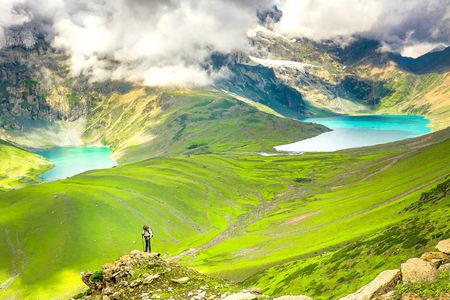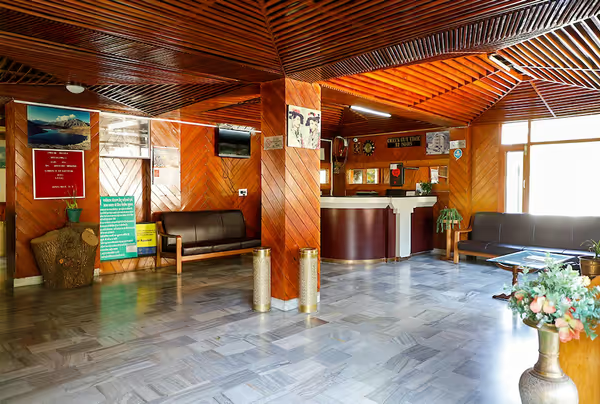Kashmir Great Lakes Trek: Your Ultimate Guide to the Scenic Trail
 Rohit Sen
21 Dec, 2024
10 mins read
284
Rohit Sen
21 Dec, 2024
10 mins read
284

The Kashmir Great Lakes Trek is an unforgettable adventure that takes trekkers through some of the most stunning landscapes in the Indian subcontinent. Nestled in the heart of the Himalayan region, this trek offers an opportunity to explore pristine alpine lakes, meadows, and rugged terrains, making it a must-do for any trekking enthusiast. If you're considering this trek, this guide provides you with all the essential information you need to make the most of your journey.
Overview of the Kashmir Great Lakes Trek
The Kashmir Great Lakes Trek is a high-altitude trek located in the Indian state of Jammu and Kashmir. Spanning around 70 kilometers, this trek typically takes about 8 days to complete. The journey offers a unique combination of challenges and scenic beauty, from snow-capped peaks and glacial lakes to meadows adorned with wildflowers.
One of the defining features of this trek is the series of breathtaking alpine lakes you'll encounter. These pristine bodies of water, such as Vishansar Lake, Krishansar Lake, and Gadsar Lake, are surrounded by towering mountains and verdant meadows, making it a photographer’s paradise.
Best Time to Undertake the Kashmir Great Lakes Trek
The best time to undertake this trek is during the summer months, from late June to early September. During this period, the weather is relatively mild, and the snow from the winter months begins to melt, revealing the stunning alpine lakes and meadows. The temperatures can vary from 5°C to 15°C during the day, but nights can get cold, dropping to around 0°C to -5°C at higher altitudes.
Avoid trekking during the winter months, as heavy snow and freezing temperatures can make the trails treacherous and difficult to navigate.
What to Expect on the Trek
The trek offers a variety of landscapes, from dense forests to barren, snow-covered ridgelines. Here’s a breakdown of some of the highlights you can expect:
- Alpine Lakes: The trek’s name comes from the series of stunning lakes that trekkers will encounter, each with its own charm. Vishansar Lake, the largest of the lakes, is known for its crystal-clear waters surrounded by snow-capped mountains. Krishansar Lake, situated in a secluded valley, is equally mesmerizing and offers the perfect spot for camping.
- Diverse Flora and Fauna: The region is home to a wide variety of wildlife, including Himalayan brown bears, musk deer, and a variety of bird species. The lush meadows are blanketed with wildflowers, adding to the vibrant beauty of the trek.
- Scenic Views: The trek offers panoramic views of the mighty Himalayas, including peaks like Mount Harmukh and the Gadsar Pass. The entire route is adorned with natural beauty, making it a photographer’s dream.
- Challenging Terrain: While the trek is moderate to challenging, it requires good fitness and preparation. You’ll be traversing rocky terrains, crossing rivers, and navigating snow-covered paths at high altitudes. It’s recommended to undergo some physical training before the trek, focusing on endurance and leg strength.
- Gadsar Pass: One of the major highlights of the trek is crossing the Gadsar Pass, situated at an altitude of 4,000 meters. The pass offers panoramic views of the surrounding mountains and is a challenging but rewarding section of the trek.
The Trekking Route and Itinerary
The Kashmir Great Lakes Trek typically follows this route:
- Day 1: Srinagar to Sonamarg: Begin your adventure with a scenic drive from Srinagar to Sonamarg, the base camp for the trek.
- Day 2: Sonamarg to Nichnai: Start the trek with a gradual ascent to Nichnai, where you’ll set up camp for the night.
- Day 3: Nichnai to Vishansar Lake: Trek through alpine meadows and small streams before reaching the breathtaking Vishansar Lake.
- Day 4: Vishansar Lake to Krishansar Lake: Hike to Krishansar Lake, enjoying the changing landscapes and dramatic views of the peaks.
- Day 5: Krishansar Lake to Gadsar Pass: Ascend to the Gadsar Pass, one of the highest points of the trek, and camp near the Gadsar Lake.
- Day 6: Gadsar Lake to Satsar Lakes: Cross several alpine lakes and meadows, reaching the famous Satsar Lakes.
- Day 7: Satsar Lakes to Gangbal Lake: Enjoy the last leg of the trek as you make your way to the serene Gangbal Lake, which marks the penultimate stop.
- Day 8: Gangbal Lake to Naranag and Drive to Srinagar: Complete your trek by descending to Naranag, where transport awaits to take you back to Srinagar.
What to Pack for the Kashmir Great Lakes Trek
Packing for the Kashmir Great Lakes Trek is crucial to ensure comfort and safety. Here’s a list of essentials:
- Trekking Gear: Sturdy trekking shoes, trekking poles, and a backpack with rain cover.
- Clothing: Layered clothing, including moisture-wicking base layers, fleece jacket, waterproof jacket, and thermal wear for the nights.
- Camping Gear: Tent, sleeping bag rated for cold temperatures, and a mat.
- Personal Items: Sunscreen, sunglasses, a first-aid kit, and water purification tablets.
- Snacks: Energy bars, dry fruits, and other lightweight, high-energy snacks.
Safety Tips for the Trek
- Altitude Sickness: As the trek involves high altitudes, it’s important to acclimatize properly. Drink plenty of water and take it slow to avoid altitude sickness.
- Weather Awareness: The weather in the mountains can be unpredictable, so always check the forecast and be prepared for rain or snow.
- Stay on the Trail: Follow the designated trekking paths and always trek with a guide if you are not experienced in high-altitude trekking.
- Keep Essential Documents: Carry necessary identification and permits, as trekking in Jammu and Kashmir requires prior permission from local authorities.
Conclusion
The Kashmir Great Lakes Trek is a spectacular journey for those seeking adventure amidst the untouched beauty of the Himalayas. With its stunning alpine lakes, diverse wildlife, and panoramic views, this trek is a once-in-a-lifetime experience that promises both challenge and awe-inspiring moments. Whether you're an experienced trekker or someone looking to step into the world of high-altitude trekking, the Kashmir Great Lakes Trek offers something for everyone. Plan your trip wisely, prepare thoroughly, and get ready for an unforgettable adventure in one of the most scenic corners of the world.
Written By:
Rohit Sen



Hotels at your convenience
Now choose your stay according to your preference. From finding a place for your dream destination or a mere weekend getaway to business accommodations or brief stay, we have got you covered. Explore hotels as per your mood.


